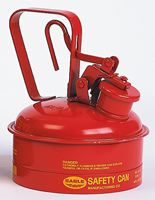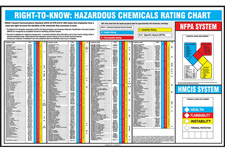



Find all of your laboratory and workplace safety supplies at Safety Emporium!
 VOC |
 Glossary Index |
 Volume Units |
| MSDS Topics |
Free Sites | FAQ's | Regulations | Glossary | Software | Suppliers |
| Books | Forum | Poll | Fun stuff | Quiz | Store | |
| Understand your MSDS with the MS-Demystifier | Search ALL our MSDS info | |||||
Volatility describes how easily a substance will vaporize (turn into a gas or vapor).
A volatile substance can be defined as (1) a substance that evaporates readily at normal temperatures and/or (2) one that has a measurable vapor pressure.
The term volatile usually applies to liquids. However, some solid materials can change directly from solid to vapor without ever becoming liquid, a process called sublimation.
The rate at which a substance vaporizes (volatilizes) under a fixed set of conditions is called the evaporation rate.

Store flammable solvents safely with safety cans and flammable storage cabinets from Safety Emporium.
The volatility of a substance is a physical property that depends on the intermolecular forces holding the atoms or molecules of the substance together. For example, methane molecules have only weak forces holding them together, so the boiling point of liquid methane is -258.9 °F (-161.6 °C). In contrast, water molecules, which have almost the same size and mass, have dipolar attraction and hydrogen bonding that make the boiling point of liquid water 212 °F (100 °C). Metals, which have some of the strongest intermolecular bonds between their atoms, may have boiling points of thousand of degrees F!
Raising the temperature supplies energy to overcome the intramolecular forces holding a solid or liquid together. Therefore, substances become more volatile (vaporize more easily) when heated. This behavior can be exploited to purify materials by distillation (see Further Reading below). However, the greater the concentration of a flammable or toxic vapor, the greater the likelihood of an explosion or accidental poisoning.
To reduce the risks associated with volatile materials, always use caution when heating them and avoid storing such materials in hot or sunny locations. Use code-approved storage such as solvent safety cans and flammable liquid storage cabinets which can reduce the likelihood and effect of a catastrophic fire.
Organic chemicals that easily form vapors are called volatile organic compounds (VOC's). Given the health and physical hazards associated with common VOC's, many companies have either reduced their use of these materials or substituted other, less hazardous, materials and processes. Substitution of this nature is called "green chemistry" as it also benefits the environment.
This term usually appears on Safety Data Sheets of materials that have a high vapor pressure. The vapor pressure, vapor density, flammability, autoignition temperature and more, if known or applicable, will be found in Section 9 (physical and chemical properties)
Depending on its vapor pressure, a volatile substance can easily form a significant concentration of vapor, especially in an enclosed space. If that vapor is flammable, a fire or explosion could result.
Other materials may emit enough vapor to exceed the permissible exposure limit (PEL) for inhalation. Always minimize your exposure to volatile chemicals by using engineering controls such as a fume hood or local exhaust ventilation. If those methods are not sufficient to protect you, be sure to use an approved respirator.

This poster from Safety Emporium contains NFPA numeric ratings for hundreds of common chemicals.
See also: boiling point, evaporation rate, NFPA, vapor pressure, ventilation.
Additional definitions from Google and OneLook.
Entry last updated: Sunday, February 6, 2022. This page is copyright 2000-2025 by ILPI. Unauthorized duplication or posting on other web sites is expressly prohibited. Send suggestions, comments, and new entry desires (include the URL if applicable) to us by email.
Disclaimer: The information contained herein is believed to be true and accurate, however ILPI makes no guarantees concerning the veracity of any statement. Use of any information on this page is at the reader's own risk. ILPI strongly encourages the reader to consult the appropriate local, state and federal agencies concerning the matters discussed herein.